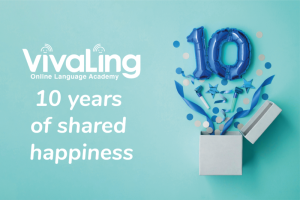Who doesn’t enjoy playing? Play is traditionally associated with childhood. From a very early age, learning is achieved through play. However, this practice is gradually lost when we become adults. VivaLing’s pedagogy places a great emphasis on games, which have been recognized for several years as a real asset in the learning process, regardless of age and goals!
A multi-faceted tool, gamification has many cognitive and emotional advantages, paving the way for effective learning – from 7 to 77 years old!
Is it possible to learn and play?
Games are a practical tool for learning, and not just for children! Simply look at the growing interest of adults in video games or escape games. The return to this fundamental childhood pleasure is proof that it should have never been abandoned!
In training, gamification (or “serious game”) is the ability to transmit knowledge through games. Gamification aims to promote learning and increase the commitment of participants.

Boosting dopamine levels
Play is fun, and fun is dopamine, the essential hormone that gives us the motivation to learn! Research confirms that positive emotions allow trainers to build together, induce adhesion, arouse attention, and improve learning.
But beware, dopamine in excess is also addictive! Without moderation, games become harmful. That is why a balanced use of gaming in session remains essential. Our coaches know the limits, thanks to their VOLT training, and they know how to extract all the best parts of this useful teaching tool.
Playing actively or not at all
It is also important to point out that some modern online games decrease the attention and commitment of the participants. This relates to the low variety of learning modalities. A beneficial game is one that questions and pushes to make assumptions.
It’s not a question of using the game for the sake of using the game. The tool must be used for educational purposes, ensuring the best possible involvement of the learner, as well as the best of his cognitive functions.
Fun and pedagogy for performance
There are rules for implementing good gamification. The best known is the “3P” rule: Pleasure, Pedagogy, and Performance. Pedagogy is a truly essential element, it’s where the learning factors in. Training must also be personalized (the second P) so that the learner feels involved.
Performance is the last P. Indeed, gamification will naturally set objectives that the learners will have to achieve. These objectives can be set by the trainers or by the learners, and a reward system can be put in place to further motivate the learners’ progress.

Playing while consolidating
Consolidation aims to move away from superficial learning towards deep brain circuits. The best method for this is repetition. That is why you may be asked to play several times during your sessions. This is not because your teacher has run out of inspiration, but simply because it is the most effective way to consolidate your knowledge! The game is progressive and has the advantage of allowing you to review your knowledge at regular and increasing intervals.
Bringing autonomy: the desire to control our lives
For adolescents, one of the most common feelings is that they do not have the freedom to learn for themselves. They often think they have ‘no choice’ due to feeling a lack of autonomy, and this can be difficult to resolve. However, applying gamification to education can help!
Widely used in the world of language learning, the system of rewards and games significantly increases the motivation of participants in their learning, especially when they are of an age where demobilization is the norm.
Rewarding progress rather than achievement
By applying gamification to learning and giving the learner a small reward, game mechanisms help learners to gauge their progress and see results. Why and how should they be rewarded? The effort of trying must be rewarded, not just the final act in its correct version (mastery).
Gamification allows the learner to feel that, even if they made a mistake, they have still made progress. As they continue play, the learner can make progress and receive a reward instead of simply failing. This practice is very similar to what you see in video games, where you are very rarely punished for trying, failing, or making a mistake.
The benefits of gamification in 7 points
You are productive and motivated. You also stimulate your creativity thanks to the many innovative games. You will be encouraged to give your best, and friendly competition provides a boost for you to excel.
You are involved because gamification implies active engagement. You benefit from innovative dynamics – say goodbye to monotonous courses! Finally, you develop your skills to solve obstacles and reach the next level.
At VivaLing we have a playful soul!
Our coaches are recruited based not only on their training and experience but also, and most importantly, their ability to use all the most modern tools to promote learning.
Some of our coaches are even gamification specialists, creating their own custom video games with their learners! They regularly share their knowledge with their colleagues through training workshops.
What about you, when was the last time you played with your coach?





